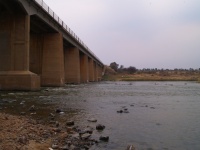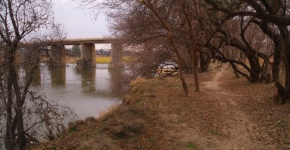


On Monday the 25 July 2011, I spent the morning at Faan Meintjies Nature Reserve and by 12 o'clock, thanks to terrible wind and unbearable dust, left the spot. I headed off to Orkney to do some birding around the Vaal River and take a look at the Orkney Bird Sanctuary that I had read about on the Internet. Armed with directions I headed on the R30 from Klerksdorp to Orkney, continued through until the dual carriage road became a single lane and looked for Smollet Road. The last road before the bridge over the Vaal River was Ingrid Jonker Road when I drove along but concluded that it was not the road leading to the entrance to the Bird Sanctuary so I continued on to the bridge on the R30 and spent a while birding on each side of the road. It is possible to walk for a few hundred meters along the river on either side without having to jump over any fences or deal with No Entry signs.
Here is a list of birds that I saw on and around the river: Chestnut-vented Tit-Babbler, Common Waxbill, Blue Waxbill, Orange River White-eye, Little Swift, Reed Cormorant, White-breasted Cormorant, Egyptian Goose, Brown-throated Martin, Cape Robin-Chat, Ashy Tit, Karoo Thrush, Black-throated Canary, Fiscal Flycatcher, African Darter, Yellow Canary, Red-billed Firefinch, Black-chested Prinia, Brown-crowned Tchagra, Cape Sparrow and Southern Masked Weaver.
Here are some scenery shots - unfortunately the weather was turning sour on me - with a few drops of rain ever now and then.
Here are a few shots that despite the poor light made the cut (seeing Orange River White-eye is always special!):
I was not finished birding for the day so I decided to try and locate the Bird Sanctuary before I headed back to Johannesburg. I fired up my GPS and found that Ingrid Jonker was the right road to take and that it lead to Ernest Heming Way where the entrance to the Bird Sanctuary is located. Here are the GPS co-ordinates for the turn off into Ingrid Jonkers Road (27°00'29.98"S 26°41'21.92"E) and for the entrance to the Reserve in Ernest Heming Way (27°00'39.22"S 26°40'50.12"E). I did not have great expectations given that the report I had read seemed to indicate that the place was no longer being maintained. But I discovered that it is a spot that is well worth visiting if you are in the area. There is a dirt road that leads down to a small dam and then a road that leads through some thorn veld to the Vaal River where you can do some more birding up and down the river.
Here are some scenery shots that I took of the dam:
Here are some scenery shots of the road to the Vaal River and of the River itself:
Here is a selection of photos I took in the Bird Sanctuary - the black and white duck I believe is a Magpie Duck (surely escaped from somewhere). Seriously the light was so bad apart from a few moments of light that appeared periodically that I really had no right taking photos.
In trying to get a closer shot of the Magpie Duck I found a second road that leads down to the dam - here are the GPS coordinates: 27°00'45.67"S 26°41'03.26"E. It is also in Ernest Heming Way - about 100 meters from the main entrance.
I usually end my trip reports with a selection of photos of mammals that I saw in the reserve - there was just one here:
Here is a full list of the birds that I saw in my short time in the Sanctuary: Greylag Goose, Egyptian Goose, Magpie Duck, Red-eyed Dove, Cape Turtle-Dove, Laughing Dove, Cape Robin-Chat, Karoo Thrush, Tawny-flanked Prinia, White-breasted Cormorant, Reed Cormorant, African Darter, Green Wood Hoopoe, Common Myna, Pied Crow, Common Fiscal, Crowned Lapwing, Wattled Starling, Speckled Pigeon, Cape Glossy Starling, White-browed Sparrow-Weaver, Cape Sparrow, Yellow-billed Duck, Blacksmith Lapwing and Little Egret.
The sad news is that a family that lives on the edge of the Sanctuary says that people from the houses around the place come to the sanctuary and shoot birds to feed to their dogs. They report the crime to the police but are just told to take down their details and nothing is done about it. This family also have some aviaries and cages on their property and it looks like they keep birds there as well. Not sure what that is all about. Clearly a situation that conservationists need to look into!